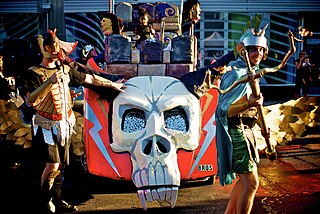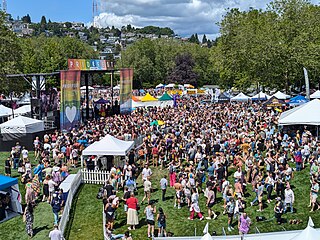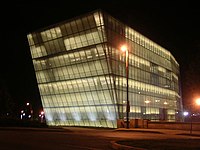
The American Film Institute (AFI) is an American nonprofit film organization that educates filmmakers and honors the heritage of the motion picture arts in the United States. AFI is supported by private funding and public membership fees.
A Baltimore accent, also known as Baltimorese and sometimes humorously spelled Bawlmerese or Ballimorese, is an accent or sub-variety of Delaware Valley English that originates among blue-collar residents of Baltimore, Maryland, United States. It extends into the Baltimore metropolitan area and northeastern Maryland.

Hampden is a neighborhood located in northern Baltimore, Maryland, United States. Roughly triangular in shape, it is bounded to the east by the neighborhood Wyman Park, to the north by Roland Park at 40th and 41st Street, to the west by the Jones Falls Expressway, and to the south by the neighborhood Remington. The Homewood campus of the Johns Hopkins University is a short distance to the east.

The Sweet Auburn Historic District is a historic African-American neighborhood along and surrounding Auburn Avenue, east of downtown Atlanta, Georgia, United States. The name Sweet Auburn was coined by John Wesley Dobbs, referring to the "richest Negro street in the world," one of the largest concentrations of African-American businesses in the United States.

The Chicago Pride Parade, also colloquially called the Chicago Gay Pride Parade or PRIDE Chicago, is an annual pride parade held on the last Sunday of June in Chicago, Illinois in the United States. It is considered a culmination of the larger Gay and Lesbian Pride Month in Chicago, as promulgated by the Chicago City Council and Mayor of Chicago. Chicago's Pride Parade is one of the largest by attendance in the world. The event takes place outside and celebrates equal rights for lesbian, gay, bisexual, transgender and queer people, which is also known as the celebration of LGBTQ rights.

The city of Baltimore, Maryland, has been a predominantly working-class town through much of its history with several surrounding affluent suburbs and, being found in a Mid-Atlantic state but south of the Mason-Dixon line, can lay claim to a blend of Northern and Southern American traditions.

Artscape is an annual art festival held in the Mount Royal neighborhood of Baltimore, Maryland in July. Since its first annual event in 1982, it has become the largest free arts festival in America. It has boasted acts such as Ray Charles, Aretha Franklin, and Matisyahu in the past, attracting over 350,000 people from the city, and surrounding areas. Film programming during Artscape is provided by Maryland Film Festival. There are artists in a variety of visual and performing media. Events are free and open to the public.

Cafe Hon was a restaurant in the Hampden area of Baltimore, Maryland.

Seattle Pride refers to a series of events which are held annually throughout the month of June to celebrate LGBT Pride in Seattle, Washington. Seattle Pride also refers to the nonprofit organization Seattle Out and Proud which coordinates and promotes LGBTQIA+ events and programs in Seattle year-round including the Seattle Pride Parade.
The history of Czechs in Baltimore dates back to the mid-19th century. Thousands of Czechs immigrated to East Baltimore during the late 19th and early 20th centuries, becoming an important component of Baltimore's ethnic and cultural heritage. The Czech community has founded a number of cultural institutions to preserve the city's Czech heritage, including a Roman Catholic church, a heritage association, a gymnastics association, an annual festival, a language school, and a cemetery. During the height of the Czech community in the late 19th century and early 20th century, Baltimore was home to 12,000 to 15,000 people of Czech birth or heritage. The population began to decline during the mid-to-late 20th century, as the community assimilated and aged, while many Czech Americans moved to the suburbs of Baltimore. By the 1980s and early 1990s, the former Czech community in East Baltimore had been almost entirely dispersed, though a few remnants of the city's Czech cultural legacy still remain.

There have been a variety of ethnic groups in Baltimore, Maryland and its surrounding area for 12,000 years. Prior to European colonization, various Native American nations have lived in the Baltimore area for nearly 3 millennia, with the earliest known Native inhabitants dating to the 10th millennium BCE. Following Baltimore's foundation as a subdivision of the Province of Maryland by British colonial authorities in 1661, the city became home to numerous European settlers and immigrants and their African slaves. Since the first English settlers arrived, substantial immigration from all over Europe, the presence of a deeply rooted community of free black people that was the largest in the pre-Civil War United States, out-migration of African-Americans from the Deep South, out-migration of White Southerners from Appalachia, out-migration of Native Americans from the Southeast such as the Lumbee and the Cherokee, and new waves of more recent immigrants from Latin America, the Caribbean, Asia and Africa have added layers of complexity to the workforce and culture of Baltimore, as well as the religious and ethnic fabric of the city. Baltimore's culture has been described as "the blending of Southern culture and [African-American] migration, Northern industry, and the influx of European immigrants—first mixing at the port and its neighborhoods...Baltimore’s character, it’s uniqueness, the dialect, all of it, is a kind of amalgamation of these very different things coming together—with a little Appalachia thrown in...It’s all threaded through these neighborhoods", according to the American studies academic Mary Rizzo.

Hollins Market is a neighborhood in the Sowebo area of Baltimore. It takes its name from the Hollins Market, the oldest public market building still in use in Baltimore City, which is located in the heart of the neighborhood.
The Flower Mart is an annual festival native to the neighborhood of Mount Vernon in Baltimore, Maryland. The Flower Mart is held each year at the beginning of May. Participants and vendors at the Flower Mart offer gardening tips, sell plants and seedlings, and other gardening-related goods. Along with vendors are various forms of live entertainment and edible treats for guests, such as its traditional lemon sticks. The Flower Mart has produced many annual traditions.
Titwrench Festival features women and LGBTQIAP artists and musicians and other underrepresented/emerging artists pushing the boundaries of genre and form. The festival began in 2009 as a showcase for the talent of female-identified people and those in the LGBTQIA communities.
Virginia S. Baker was an American civil servant and employee of the Department of Recreation and Parks in Baltimore City, Maryland, U.S. She was known by a number of nicknames, such as Queenie, Queen of Fun, Baltimore's First Lady of Fun, "queen of the hill", and "Baltimore's oldest kid". In 1984, the recreation center in Patterson Park was named the Virginia S. Baker Recreation Center to honor Baker's years of service to the center and to the children of Baltimore.
The city of Baltimore, Maryland includes a significant Appalachian population. The Appalachian community has historically been centered in the neighborhoods of Hampden, Pigtown, Remington, Woodberry, Lower Charles Village, Highlandtown, and Druid Hill Park, as well as the Baltimore inner suburbs of Dundalk, Essex, and Middle River. The culture of Baltimore has been profoundly influenced by Appalachian culture, dialect, folk traditions, and music. People of Appalachian heritage may be of any race or religion. Most Appalachian people in Baltimore are white or African-American, though some are Native American or from other ethnic backgrounds. White Appalachian people in Baltimore are typically descendants of early English, Irish, Scottish, Scotch-Irish, and Welsh settlers. A migration of White Southerners from Appalachia occurred from the 1920s to the 1960s, alongside a large-scale migration of African-Americans from the Deep South and migration of Native Americans from the Southeast such as the Lumbee and the Cherokee. These out-migrations caused the heritage of Baltimore to be deeply influenced by Appalachian and Southern cultures.

The history of White Americans in Baltimore dates back to the 17th century when the first white European colonists came to what is now Maryland and established the Province of Maryland on what was then Native American land. White Americans in Baltimore are Baltimoreans "having origins in any of the original peoples of Europe, the Middle East or North Africa." Majority white for most of its history, Baltimore no longer had a white majority by the 1970s. As of the 2010 census, white Americans are a minority population of Baltimore at 29.6% of the population. White Americans have played a substantial impact on the culture, dialect, ethnic heritage, history, politics, and music of the city. Since the earliest English settlers arrived on the shores of the Chesapeake Bay, Baltimore's white population has been sustained by substantial immigration from all over Europe, particularly Central Europe, Eastern Europe, and Southern Europe, as well as a large out-migration of White Southerners from Appalachia. Numerous white immigrants from Europe and the European diaspora have immigrated to Baltimore from the United Kingdom, Germany, Ireland, Poland, Italy, the Czech Republic, Slovakia, Lithuania, Russia, Ukraine, Spain, France, Canada, and other countries, particularly during the late 19th century and early 20th century. Smaller numbers of white people have immigrated from Latin America, the Caribbean, the Middle East, North Africa, and other non-European regions. Baltimore also has a prominent population of white Jews of European descent, mostly with roots in Central and Eastern Europe. There is a smaller population of white Middle Easterners and white North Africans, most of whom are Arab, Persian, Israeli, or Turkish. The distribution of White Americans in Central and Southeast Baltimore is sometimes called "The White L", while the distribution of African Americans in East and West Baltimore is called "The Black Butterfly."
The city of Baltimore, Maryland includes a large and growing Caribbean-American population. The Caribbean-American community is centered in West Baltimore. The largest non-Hispanic Caribbean populations in Baltimore are Jamaicans, Trinidadians and Tobagonians, and Haitians. Baltimore also has significant Hispanic populations from the Spanish West Indies, particularly Puerto Ricans, Dominicans, and Cubans. Northwest Baltimore is the center of the West Indian population of Baltimore, while Caribbean Hispanics in the city tend to live among other Latinos in neighborhoods such as Greektown, Upper Fell's Point, and Highlandtown. Jamaicans and Trinidadians are the first and second largest West Indian groups in the city, respectively. The neighborhoods of Park Heights and Pimlico in northwest Baltimore are home to large West Indian populations, particularly Jamaican-Americans.












